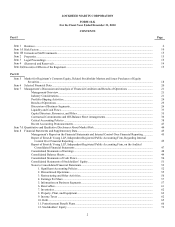Lockheed Martin 2010 Annual Report Download - page 17
Download and view the complete annual report
Please find page 17 of the 2010 Lockheed Martin annual report below. You can navigate through the pages in the report by either clicking on the pages listed below, or by using the keyword search tool below to find specific information within the annual report.9
Administration, NASA, the Environmental Protection Agency (EPA), the National Archives, and the Library of Congress. Similar
government authorities exist in other countries and regulate our international efforts.
We must comply with and are affected by laws and regulations relating to the formation, administration, and performance of
U.S. Government and other contracts. These laws and regulations, among other things:
• require certification and disclosure of all cost or pricing data in connection with certain contract negotiations;
• impose specific and unique cost accounting practices that may differ from U.S. generally accepted accounting principles
(GAAP) and therefore require reconciliation;
• impose acquisition regulations that define allowable and unallowable costs and otherwise govern our right to
reimbursement under certain cost-based U.S. Government contracts;
• restrict the use and dissemination of information classified for national security purposes and the export of certain
products and technical data; and
• require the use of earned valued management systems (EVMS) for managing cost and schedule performance on certain
complex programs.
For additional discussion of government contracting laws and regulations, see “Risk Factors” beginning on page 10 and
“Industry Considerations” in Management’s Discussion and Analysis of Financial Condition and Results of Operations beginning on
page 23 of this Form 10-K.
A portion of our business is classified by the U.S. Government and cannot be specifically described. The operating results of
these classified programs are included in our consolidated financial statements. The business risks associated with classified programs
historically have not differed materially from those of our other government programs.
Backlog
At December 31, 2010, our total negotiated backlog was $78.2 billion compared with $77.2 billion at the end of 2009. Of our
total 2010 year-end backlog, approximately $43.8 billion, or 56%, is not expected to be filled within one year.
Our backlog includes both funded (unfilled firm orders for our products and services for which funding has been both
authorized and appropriated by the customer – Congress, in the case of U.S. Government agencies) and unfunded (firm orders for
which funding has not been appropriated) amounts. We do not include unexercised options or potential indefinite-delivery, indefinite-
quantity (IDIQ) orders in our backlog. If any of our contracts were to be terminated, our backlog would be reduced by the expected
value of the remaining terms of such contracts. Funded backlog was $49.7 billion at December 31, 2010. The backlog for each of our
business segments is provided as part of Management’s Discussion and Analysis of Financial Condition and Results of Operations –
“Discussion of Business Segments” beginning on page 29 of this Form 10-K.
Research and Development
We conduct research and development activities under customer-funded contracts and with our own independent research and
development funds. Our independent research and development costs include basic research, applied research, development, systems,
and other concept formulation studies. These costs generally are allocated among all contracts and programs in progress under U.S.
Government contractual arrangements. Corporation-sponsored product development costs not otherwise allocable are charged to
expense when incurred. Under certain arrangements in which a customer shares in product development costs, our portion of the
unreimbursed costs is expensed as incurred. Independent research and development costs charged to costs of sales were $638 million
in 2010, $724 million in 2009, and $698 million in 2008. See “Research and development and similar costs” in Note 1 – Significant
Accounting Policies on page 57 of this Form 10-K.
Employees
At December 31, 2010, we had approximately 132,000 employees, over 90% of whom were located in the U.S. We have a
continuing need for numerous skilled and professional personnel to meet contract schedules and obtain new and ongoing orders for
our products. The majority of our employees possess a security clearance. The demand for workers with security clearances who have
specialized engineering, information technology, and technical skills within the aerospace, defense, and information technology
industries is likely to remain high for the foreseeable future, while growth of the pool of trained individuals with those skills has not
matched demand. As a result, we are competing with other companies with similar needs in hiring skilled employees. Management
considers employee relations to be good.
Approximately 15% of our employees are covered by any one of approximately 70 separate collective bargaining agreements
with various unions. A number of our existing collective bargaining agreements expire in any given year. Historically, we have been
successful in renegotiating expiring agreements without any material disruption of operating activities.
























